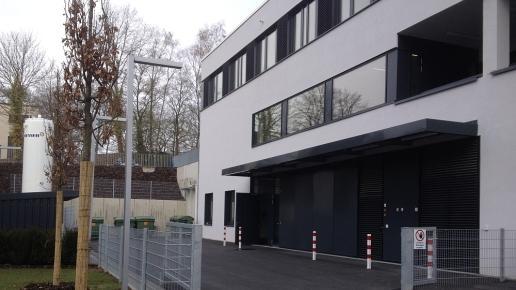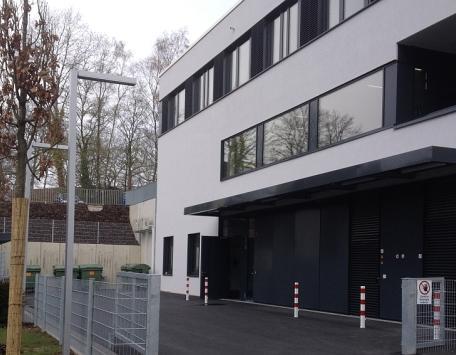Chemistry service
ChEV - Department for Chemicals Disposal and Supply
In our department, we stock all common chemicals for the university's laboratories. Other chemicals and gases of all kinds can be ordered here.
Our tasks also include the acceptance and interim storage of hazardous waste and electronic waste generated at the university. We are happy to answer any questions regarding the transportation of hazardous goods.
A glass-blowing workshop has been part of the university's research and teaching service since it was founded. Broken glass can be ordered here for repair or custom-made items for research.

We are located in the Department of Chemistry and Biology on the Adolf Reichwein Campus (AR), but take care of all matters concerning the university's chemistry service centrally.
We offer:
- Chemical supply
Provision of common laboratory chemicals, ordering service for special chemicals - Gas supply
Procurement of gases and liquid nitrogen for all areas of the university - Glass blowing:
Repair of broken glass, custom-made products for research and teaching, quartz glass work - Disposal of hazardous waste:
Acceptance and temporary storage of hazardous waste, provision of suitable containers, advice on hazardous waste and hazardous goods transportation
Chemical supply

Gas supply

Glassblowing

Hazardous waste disposal

The central gas supply and hazardous waste disposal supports those responsible in accordance with the hazardous waste guidelines of the University of Siegen with
- the acceptance and temporary storage of hazardous waste
- providing suitable containers for the usual types of waste
- passing on hazardous waste to the specialist disposal company
- Handling the formalities for transportation
- consulting
The professional responsibility for the
- Prevention and reduction of hazardous waste
- Compliance with the university's hazardous waste guidelines
- Collection, declaration and labeling of hazardous waste
- Compliance with transportation regulations when transporting to the central gas supply and hazardous waste disposal or to the disposal company
is the responsibility of the respective heads of the University's facilities, who determine the type and scope of the respective research work. Any delegation of responsibility is excluded.
Hazardous waste in the AR building is disposed of directly via the central gas supply and hazardous waste disposal of the University of Siegen in the AR-NC building. All other properties can register their hazardous waste there.
Collection of hazardous waste in the laboratories and workshops
- Small interim storage facilities that comply with the relevant regulations are permitted and appropriate.
- In principle, waste should be collected separately as far as possible.
- As a rule, it is not feasible to recycle mixed waste.
- Waste that is subject to a transport ban (e.g. aqua regia) must be converted into a transportable state (here: neutralized)
- The handling of waste must be recorded in the relevant laboratory regulations or operating instructions.
Labeling
- Gas Supply and Hazardous Waste Disposal provides labels for labeling the collection containers in accordance with regulations. The labels are issued with the containers and must be affixed to the container by the waste producer after completing all relevant data.
- All waste containing hazardous substances must be labeled in accordance with the Hazardous Substances Ordinance. For this purpose, the waste must be classified according to the hazards it may pose.
- The classification should be based on the properties of the most hazardous substance.
The label should contain the following:
- The name of the waste (example: solvent, containing halogen).
- The hazard symbols and hazard designation according to the classification. In the case of corrosive waste, it must also be indicated whether the waste has an acidic or alkaline reaction.
- The information on special hazards (H-phrases) if the waste has hazardous properties that are not recognizable from the hazard symbols used.
- The safety advice (P-phrases) must be indicated if they are relevant to the waste processing activity.
- Name and working group of the waste producer.
- Hazard symbols according to the Dangerous Goods Ordinance Road/Rail (GGVSEB), as our containers are transported on public roads.
- Provide as precise information as possible regarding the contents of the individual containers. Internal laboratory abbreviations or trivial names are not sufficient.
- Regardless of the type of waste or residual materials, all containers must be clearly labeled. Old, inapplicable labels must be removed and dirty or illegible labels must be replaced.
Packaging of waste (collection containers)
- Suitable collection containers (approved for transportation in accordance with GGVSEB) are provided by the central gas supply and hazardous waste disposal department for the individual types of waste. These can be collected or requested there if required.
- These containers must be set up in the laboratories in such a way that they do not pose a hazard.
- Packaging must be leak-proof, clean on the outside, suitable for the contents and approved.
- Particularly in the case of collection containers for flammable substances, care must be taken to ensure that they are placed in well-ventilated areas (fume hood if necessary).
- When storing the blue garbage cans in the laboratories, the lids must be kept closed with the clamping ring.
- Flammable liquids must be collected in conductive containers, acids, alkalis and metal salt solutions must be collected in plastic canisters with a maximum capacity of 10 liters and with UN approval.
- Water-polluting waste must be collected in places where no pollution of the groundwater or waste water can occur if it escapes (e.g. collection tray).
- Collection containers for solvents and other liquids may only be filled to a maximum of 90% to prevent overflowing or bursting due to thermal expansion.
- Prohibitions on combined storage must be observed.
Separate according to:
- Waste with flammable solid inorganic and organic substances
- z. e.g.: contaminated paper towels, filter materials, gloves or other solid chemically contaminated waste (no glass)
- Blue waste garbage can and with label: absorbent and filter materials
- z. e.g.: contaminated paper towels, filter materials, gloves or other solid chemically contaminated waste (no glass)
- Chemically contaminated glass waste
- z. e.g.: defective glass appliances or snap lid jars with residual chemicals up to approx. 5 g
- Blue waste garbage can with label: Glass waste
- z. e.g.: defective glass appliances or snap lid jars with residual chemicals up to approx. 5 g
- Organic solvents
- separated according to halogen content (e.g. chloroform)
- Black waste garbage can with label: halogenated hydrocarbons
- and halogen-free (e.g. acetone, ethanol, hexane)
- Black waste containers with label: halogen-free hydrocarbons
- separated according to halogen content (e.g. chloroform)
- Liquid waste with corrosive and toxic substances
- z. B.: Acids and alkalis or contaminated washing water
- White waste containers with label: washing water
- z. B.: Acids and alkalis or contaminated washing water
- Contaminated plastic or metal containers
- can be disposed of directly at the hazardous waste disposal center or at the pollutant collection point
- Chemicals in original containers with residual contents
- will be handed in to the hazardous waste disposal or pollutant collection after consultation
- Batteries
- are separated into household batteries, lithium-ion batteries and car batteries (separated according to acid or alkaline) and handed in at the hazardous waste disposal or pollutant collection points
Transportation and delivery to the disposal point
The following regulations must be observed when delivering waste:
For the Adolf- Reichwein Straße property:
- During opening hours, the employees of the central gas supply and hazardous waste disposal will accept hazardous waste that accumulates in the AR building area and issue new containers.
- The hazardous waste is weighed and registered according to the type of waste, with the name of the waste producer and the working group.
- Proper packaging and declaration are checked.
- Waste and waste packages that do not meet the above requirements may be rejected. This is necessary to ensure occupational safety at the disposal station.
- The substances must not release any gases or contain flammable components (filter paper and paper with catalyst residues and/or oxidizing agents such as sulphuric acid or nitric acid).
For the other university buildings:
- Hazardous waste is registered in writing with the central gas supply and hazardous waste disposal department by means of a disposal application.
- Hazardous waste disposal is carried out approximately once a quarter as an internal collection of hazardous substances at the registered properties.
- The transportation of hazardous substances and hazardous waste in your own car is not permitted. If hazardous goods have to be transported by car for business purposes, this is only permitted in accordance with the provisions of the GGVSEB and the ADR!
The contents of this page have been compiled to the best of our knowledge and with the greatest possible care. Nevertheless, we cannot guarantee that it is correct, complete or up to date.
Hazardous waste in the AR building is disposed of via the central gas supply and hazardous waste disposal of the University of Siegen in the AR-NC building.
All other properties register their hazardous waste there.
Hazardous waste disposal is carried out approximately twice a year as an internal collection of hazardous waste at the registered properties.
It is separated into
- Waste with flammable solid inorganic and organic substances
- e.g.: contaminated paper towels, filter materials, gloves or other solid chemically contaminated waste (no glass)
- Blue waste garbage can with label: absorbent and filter materials
- e.g.: contaminated paper towels, filter materials, gloves or other solid chemically contaminated waste (no glass)
- Chemically contaminated glass waste
- e.g.: defective glass appliances or snap lid jars with residual chemicals up to approx. 5 g
- Blue waste garbage can with label: Glass waste
- e.g.: defective glass appliances or snap lid jars with residual chemicals up to approx. 5 g
- Organic solvents
- separated according to halogen content (e.g. chloroform)
- Black waste garbage can with label: halogenated hydrocarbons
- and halogen-free (e.g. acetone, ethanol, hexane)
- Black waste containers with label: halogen-free hydrocarbons
- separated according to halogen content (e.g. chloroform)
- Liquid waste with corrosive and toxic substances
- z. B.: Acids and alkalis or contaminated washing water
- White waste containers with label: washing water
- z. B.: Acids and alkalis or contaminated washing water
- Contaminated plastic or metal containers
- can be disposed of directly at the hazardous waste disposal center or at the pollutant collection point
- Chemicals in original containers with residual contents
- can be handed in to the hazardous waste disposal or pollutant collection after consultation
- Batteries
- are separated into household batteries, lithium-ion batteries, car batteries (here separated into acid or alkaline) and handed in at the hazardous waste disposal or pollutant collection points
Waste containers and labels are available from the hazardous waste disposal service.
